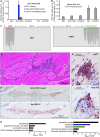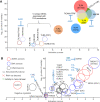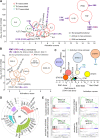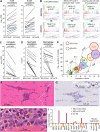Injection site vaccinology of a recombinant vaccinia-based vector reveals diverse innate immune signatures
- PMID: 33439897
- PMCID: PMC7837487
- DOI: 10.1371/journal.ppat.1009215
Injection site vaccinology of a recombinant vaccinia-based vector reveals diverse innate immune signatures
Abstract
Poxvirus systems have been extensively used as vaccine vectors. Herein a RNA-Seq analysis of intramuscular injection sites provided detailed insights into host innate immune responses, as well as expression of vector and recombinant immunogen genes, after vaccination with a new multiplication defective, vaccinia-based vector, Sementis Copenhagen Vector. Chikungunya and Zika virus immunogen mRNA and protein expression was associated with necrosing skeletal muscle cells surrounded by mixed cellular infiltrates. The multiple adjuvant signatures at 12 hours post-vaccination were dominated by TLR3, 4 and 9, STING, MAVS, PKR and the inflammasome. Th1 cytokine signatures were dominated by IFNγ, TNF and IL1β, and chemokine signatures by CCL5 and CXCL12. Multiple signatures associated with dendritic cell stimulation were evident. By day seven, vaccine transcripts were absent, and cell death, neutrophil, macrophage and inflammation annotations had abated. No compelling arthritis signatures were identified. Such injection site vaccinology approaches should inform refinements in poxvirus-based vector design.
Conflict of interest statement
I have read the journal's policy and the authors of this manuscript have the following competing interests: NAP, LL and JDH own Sementis shares. JDH is the current CSO of Sementis. AS was a consultant for Sementis. PMH was the previous CEO/CSO of Sementis. LL and NAP have had, and/or currently have, salary and/or project support from funds provided, whole or in part, via Sementis. Sementis had no role in the design and interpretation of the study, or in preparation of the manuscript.
Figures






Similar articles
-
A vaccinia-based single vector construct multi-pathogen vaccine protects against both Zika and chikungunya viruses.Nat Commun. 2018 Mar 26;9(1):1230. doi: 10.1038/s41467-018-03662-6. Nat Commun. 2018. PMID: 29581442 Free PMC article.
-
A Vaccine Based on a Modified Vaccinia Virus Ankara Vector Expressing Zika Virus Structural Proteins Controls Zika Virus Replication in Mice.Sci Rep. 2018 Nov 26;8(1):17385. doi: 10.1038/s41598-018-35724-6. Sci Rep. 2018. PMID: 30478418 Free PMC article.
-
B5-deficient vaccinia virus as a vaccine vector for the expression of a foreign antigen in vaccinia immune animals.Virology. 2007 May 10;361(2):356-63. doi: 10.1016/j.virol.2006.11.020. Epub 2006 Dec 26. Virology. 2007. PMID: 17188733 Free PMC article.
-
Poxvirus-based vector systems and the potential for multi-valent and multi-pathogen vaccines.Expert Rev Vaccines. 2018 Oct;17(10):925-934. doi: 10.1080/14760584.2018.1522255. Epub 2018 Oct 9. Expert Rev Vaccines. 2018. PMID: 30300041 Review.
-
Poxviruses as vaccine vectors.Comp Immunol Microbiol Infect Dis. 2003 Oct;26(5-6):343-55. doi: 10.1016/S0147-9571(03)00019-5. Comp Immunol Microbiol Infect Dis. 2003. PMID: 12818621 Review.
Cited by
-
The vaccinia-based Sementis Copenhagen Vector coronavirus disease 2019 vaccine induces broad and durable cellular and humoral immune responses.Immunol Cell Biol. 2022 Apr;100(4):250-266. doi: 10.1111/imcb.12539. Epub 2022 Mar 13. Immunol Cell Biol. 2022. PMID: 35188985 Free PMC article.
-
EDIII-Fc induces protective immune responses against the Zika virus in mice and rhesus macaque.PLoS Negl Trop Dis. 2023 Nov 20;17(11):e0011770. doi: 10.1371/journal.pntd.0011770. eCollection 2023 Nov. PLoS Negl Trop Dis. 2023. PMID: 37983259 Free PMC article.
-
Current Advances in Zika Vaccine Development.Vaccines (Basel). 2022 Oct 28;10(11):1816. doi: 10.3390/vaccines10111816. Vaccines (Basel). 2022. PMID: 36366325 Free PMC article. Review.
-
Poxviruses and the immune system: Implications for monkeypox virus.Int Immunopharmacol. 2022 Dec;113(Pt A):109364. doi: 10.1016/j.intimp.2022.109364. Epub 2022 Oct 22. Int Immunopharmacol. 2022. PMID: 36283221 Free PMC article. Review.
-
Coding-Complete Genome Sequences of Copenhagen and Copenhagen-Derived vP811 Strains of Vaccinia Virus Isolated from Cell Culture.Microbiol Resour Announc. 2023 Apr 18;12(4):e0009023. doi: 10.1128/mra.00090-23. Epub 2023 Mar 22. Microbiol Resour Announc. 2023. PMID: 36946721 Free PMC article.
References
-
- Koch T, Dahlke C, Fathi A, Kupke A, Krahling V, Okba NMA, et al. Safety and immunogenicity of a modified vaccinia virus Ankara vector vaccine candidate for Middle East respiratory syndrome: an open-label, phase 1 trial. Lancet Infect Dis. 2020;20: 827–838. 10.1016/S1473-3099(20)30248-6 - DOI - PMC - PubMed
-
- Pantaleo G, Janes H, Karuna S, Grant S, Ouedraogo GL, Allen M, et al. Safety and immunogenicity of a multivalent HIV vaccine comprising envelope protein with either DNA or NYVAC vectors (HVTN 096): a phase 1b, double-blind, placebo-controlled trial. Lancet HIV. 2019;6: e737–e749. 10.1016/S2352-3018(19)30262-0 - DOI - PMC - PubMed
-
- Laher F, Moodie Z, Cohen KW, Grunenberg N, Bekker LG, Allen M, et al. Safety and immune responses after a 12-month booster in healthy HIV-uninfected adults in HVTN 100 in South Africa: A randomized double-blind placebo-controlled trial of ALVAC-HIV (vCP2438) and bivalent subtype C gp120/MF59 vaccines. PLoS Med. 2020;17: e1003038 10.1371/journal.pmed.1003038 - DOI - PMC - PubMed
Publication types
MeSH terms
Substances
LinkOut - more resources
Full Text Sources
Other Literature Sources
Medical
Research Materials
Miscellaneous

